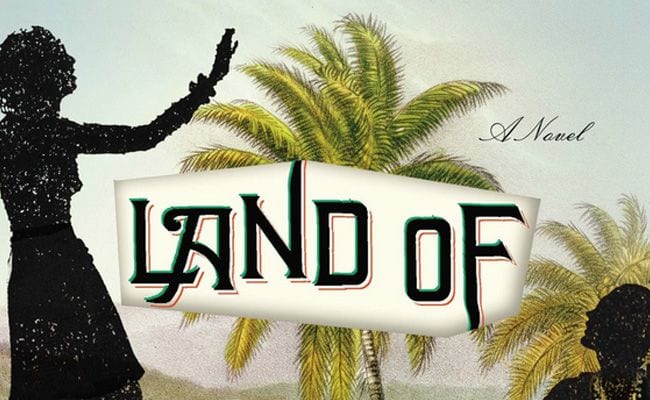
In the author’s note to Land of Love and Drowning, Tiphanie Yanique explains that her book is partially a response to Herman Wouk’s novel Don’t Stop the Carnival, and partially a reaction to the softcore porn film, Girls Are for Loving. She notes which characters are based on real people and talks about the personal history she incorporated into the story. She provides titles of academic texts that were important to the formation of the book and mentions a painter that she “owe[s] much to”.
Still, it’s the last line of this note that really sticks out: “The rest is magic and myth—fiction, as we call it.”
There is perhaps no better way to describe this novel: magic and myth.
Set primarily in the Caribbean, the story focuses on two orphaned sisters. Eeona is the older, more class-conscious sister who is concerned with properly crossed legs, curtseying, and teaching her sister not to talk “Frenchy”. Anette is the younger sister, whose narration begins while she is still in the womb: “Don’t mind I ain born yet. I is the historian in this family. Teacher of history at the Anglican school where all the fancy families does send their children. So is me could really tell you what happen on Transfer Day. If anyone know the history is me. Nowadays people think historians are stuffy types, but history is a kind of magic…”
And it’s not just history—science is magic, water is magic. Names have magic. Magic is all around. From silver pubic hair to characters with hooves instead of feet to a car that will only work for certain people, Yanique creates a book full of magical realism.
She also creates a story with plenty of realism. The book follows the lives of Eeona and Anette, who are left nearly penniless after their parents die. They must leave their childhood home, and much of the rest of the book details their search for a new home. And they are looking for a home in every sense of the word–not just a building for shelter and stability, but a place to call their own.
This seems to be the case for many in the book—almost all are searching for a home and an identity in a story that opens on 31 March 1917—the day St. Thomas, St. John, and St. Croix became the U.S. Virgin Islands and moved from Danish to American control.
“Americanness”, as most can probably guess, is not all it’s cracked up to be. At the official transfer ceremony, there’s the spit and polish, the raising of the U.S. flag, the playing of the national anthems, and the shiny brass buttons on the military dress uniforms. Later, there’s the draft and the realization that the United States may want its newest members to help fight wars, but perhaps not much else: “It was easy. There was war. We had to prove something to the nation, it seemed. Prove we were worthy of the U.S. passports they’d allowed us.”
An achingly memorable passage occurs when three male characters, including Anette’s half brother Jacob, are stationed in New Orleans and are threatened and forced to leave a restaurant (they don’t see the sign that says NO COLOREDS ALLOWED). Jacob “…understood. Here was a story like his schoolmates had told. Here it was… He was going to be a doctor. Could play piano better than anybody. Could swim like he came from the ocean. This kid in suspenders couldn’t see all that. But surely he could see that they were in uniform. That they had shined their shoes.”
While it isn’t always easy for the Caribbean characters to find a home in the continental United States, people from the U.S. seem to have no such problems when looking for space in St. Thomas or St. Croix. The negative impact of tourism is another theme in the story, and perhaps nowhere is this clearer than Yanique’s fictionalized description of the making of Girls Are for Loving.
The end result is a story with depth and many layers, and many narrators. In addition to Eeona and Annette, several other characters tell their stories in their own voices. While there’s a mythic or almost fairy tale tone (think of the original ones, the tales that don’t always have happily ever after endings), the characters are well developed and empathic; Yanique does a wonderful job of giving each character a unique voice.
Yanique also includes a rather (overly?) authoritative omniscient narrator—a narrator who not only fills in details and tells us the “truth” when the characters seem unwilling to do so, but who also reminds us to be fair when we might be siding with one character more than another. This is a narrator with strong opinions on almost everything, including the changing landscape of the islands: “St. Thomas was such a strange place now. The island was not the same, and its native sons returning would not make it the same again. The owner of Eeona’s flat had uprooted Eeona’s back garden to make room for pavement so the neighbor woman from Jost Van Dyke could park her car.”
Land of Love and Drowning is Yanique’s debut novel. It’s ambitious, creative, and thoughtful with a beautifully strong sense of place. The tale begins a little slowly, but the magical realism seems effortless and believable and makes me hope Yanique is already at work on her next novel.


![Call for Papers: All Things Reconsidered [MUSIC] May-August 2024](https://www.popmatters.com/wp-content/uploads/2024/04/all-things-reconsidered-call-music-may-2024-720x380.jpg)



